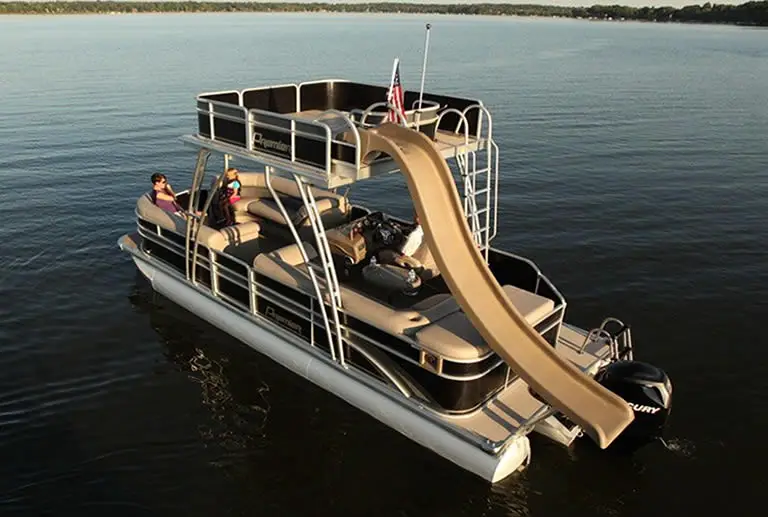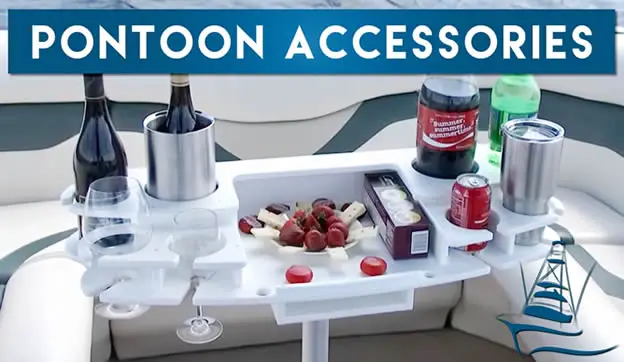A pontoon boat has a completely flat bottom hull, but unlike other flat bottom boats a pontoon boat sits on two tubes, called pontoons, that provide it with buoyancy. Many people wonder how these strange looking vessels actually work and how they float, so let’s take a look at that now. How does a pontoon boat float?
Pontoon boats have a flat-bottomed hull that relies on long cylindrical tubes, called pontoons, for buoyancy. Pontoon boats float, via their pontoons, due to the principle of flotation that states when an boat displaces an amount of weight in water that is equal to its own weight then the boat will float.
As the pontoons on a pontoon boat displace more water than the combined weight of the boat and pontoons, the pontoon boat floats.
Contents
How a pontoon boat works
Pontoon boats are fairly simple watercraft as far as their construction design goes. They have a simplistic hull that sits on top of two long tubes.
The main bulk of a pontoon boat consists of a simple flat platform that acts as the hull of the boat. Sometimes there will be an additional smaller flat platform which sits above the first platform and acts as an upper deck.
Although the hull of the boat has a flat bottom design that would usually float without any aid, just like a raft (see my other website for an explanation on that), the type of weight a pontoon boat carries means it needs additional buoyancy support. This extra buoyancy comes in the form of pontoons, sometimes called tubes, logs or toons (this term is often used to describe smaller pontoons, like those used on boat lifts for example).
The pontoons work to add buoyancy to the boat. They are not filled with nitrogen or some other lighter-than-air gas to help them float better as many people mistakenly believe. They are hollow tubes that may sometimes be filled with air, but that is for a completely different reason which you can read about here. Pontoons work through water displacement, which I will talk about later.
The pontoons are attached underneath the deck at the port and starboard sides of the boat.
Without the aid of pontoons, a pontoon boat would be too heavy to float.
So how do the pontoons help keep the boat afloat?
Well, it’s all about the buoyancy of the pontoons underneath the deck and the principle of flotation.
How do pontoon boats float? It’s about the buoyancy of the pontoons
To understand how a pontoon boat floats we need to look at some basic principles of the water namely; net buoyant force and the principle of flotation. Both of these are based on Archimedes’ Principle which is a basic law of physics. Read this Wikipedia entry if you want a more boring scientific explanation of how this works. I will try to explain it as best I can in layman’s terms (wish me luck!).
To see why a pontoon boat floats we will look at how the above two principles interact with the pontoons on a pontoon boat.
First, we will look at net buoyancy force.
Explanation of net buoyant force
What is net buoyant force and how does it help a pontoon boat to float?
When a pontoon boat enters a body of water it automatically displaces some water; the part of the boat that is in the water essentially moves water out of its way and takes its place. The water underneath the boat then pushes the boat upwards (this is called buoyancy force), while at the same time gravity is pushing the boat down.
The net buoyant force refers to the difference in pressure between the buoyancy force pushing the boat up and out of the water (from the water beneath the boat) and the gravitational force that is pushing the boat down into the water.
- If the gravitational force is greater than the buoyancy force the boat will sink. We say that the net buoyancy force is negative (-).
- If these forces are equal then the boat will float. We say that the net buoyancy force is zero.
- If the buoyancy force is greater than the gravitational force the boat will float – or rise to the surface if it is submerged. We say that the net buoyant force is positive (+).
The equation for determining the net buoyancy of a boat is as follows:
Net buoyant force = buoyant force – mass of the boat
Hopefully that all makes sense and isn’t too difficult to follow.
In basic terms it means that a pontoon boat must have greater buoyant force than the force of gravity that is acting on the mass of the boat.
It does this with the aid of flotation tubes called pontoons.
If the concept of net buoyancy force is difficult to follow then luckily there is an easier way to look at how pontoon boats float and that is through studying the principle of flotation.
The principle of flotation
The principle of flotation also has its basis in Archimedes’ Principle.
The principle explains how objects float in a fluid. In our case we will look at how this principle is related to how a pontoon boat floats in water.
The principle of flotation states that any object will float if it displaces the same weight in water that is equal to its own weight.
As far as a pontoon go this principle can be stated as follows:
When a pontoon boat displaces an amount of water that has the same weight as its own weight, the pontoon boat will float.
… and …
When a pontoon boat displaces an amount of water that is heavier than its own weight, the pontoon boat will float.
This principle is why seriously heavy boats, like the gigantic Pioneering Spirit that weights a massive 900,000 tons, can float. Pioneering Spirit may weigh 900,000 tons but because it displaces water that weighs more than that, it floats.
How do pontoons float and maintain buoyancy?
When it comes to a pontoon boat, it is the pontoons (also called pontoon tubes, pontoon logs, pontoon floats, and toons), that are responsible for the water displacement that keeps the boat a float.
As I already highlighted above, when a boat displaces an amount of water that has the same weight as its own weight, the boat will float. The pontoons on a pontoon boat displace enough water so that the water displaced is heavier than the boat and thus they keep the pontoon boat afloat.
However, when you overload a pontoon boat the weight of the pontoons, and the boat combined, are greater than the weight of the water that is being displaced and the boat will start to sink.
Poor weight distribution on the boat can also make the weight on the pontoons uneven causing problems with buoyancy in specific areas of the boat.
As pontoon boats are meant to be heavier at the stern than the bow, for optimal performance, if too much weight is placed at at the front of the boat the front parts of the pontoons will be supporting weight that is heavier than the weight of the water being displaced there. This is the biggest cause for a pontoon boat taking a nosedive.
How to make a pontoon boat more buoyant
To improve the buoyancy of a pontoon boat and make it float better all you have to do is add another pontoon tube.
As I highlighted in a previous article, a pontoon tube is the main component of the boat that gives it buoyancy.
By adding an extra pontoon tube underneath the boat you add extra buoyancy and effectively turn your pontoon boat into a tritoon boat – see tritoon vs pontoon for more information.
How the boat is able to move
The final piece that makes a pontoon boat works concerns propulsion. (I told you they were simple boats). Propulsion makes the boat go and is provided by an outboard or inboard motor.
A pontoon boat is a motorized vessel and is powered by one or more powerful outboard motors.
The baseline motor for an average pontoon boat is 115 hp. However, bigger pontoon boats will be equipped with much more powerful motors.
In the 21′ – 24′ pontoon boat size ranges it is common to see a 150 hp – 175 hp motor mounted on the boat.
Tritoons, pontoon boats that have three pontoons instead of 2 two, are usually much bigger boats and can be powered by outboard motors ranging from 200 hp – 225 hp.
The motor is controlled via a central console control with steering wheel mechanism. This makes driving a pontoon boat easy.
Some pontoon boats will be fitted with two or even three motors for extra power and speed.
If you want to know how pontoon boats are used be sure to read this article. We also have 15 reasons why pontoon boats are the best.
You may also be interested in reading our article on the 55 best pontoon boat accessories especially if you want to have a pontoon boat party or use your vessel for other fun activities.



